Grady-White has been building consoles for more than 40 years, but the model delivered by Short Marine — which they kindly permitted The Captain to abuse, er, test drive on Sydney Harbour — boasts several 21st-century smarts, including a Seakeeper 1 gyroscopic stabiliser.
When it comes to stable fishing platforms, Grady-White boats rank among the best. Their C Raymond Hunt-inspired SeaV² variable deadrise deep-vee hulls offer a killer balance of stability at rest and on the move — as well as flared bow narrowing down to a slat-slicing water entry. The hull has 30 degrees of deadrise amidships, tapering out to 20 at the transom. Some call it the perfect boating recipe. But that alone wasn’t appetising enough for one of Short Marine’s more discerning customers, who insisted on a Seakeeper 1 (SK1) stabiliser before handing over the loot. The customer also had a long list of other demands. Being a fan of console boats – and Grady-Whites — The Captain kept a close eye on this fit-up.
GETTING CRAFTY
It wasn’t just a matter of ticking boxes for this customer. For starters, Grady-White doesn’t offer a Seakeeper option. So the Short Marine crew got out the measuring tape and diamond saw, and set about creating a cavity inside the belly of a Canyon 271. “We had to get underneath the fish box, which involved quite a bit of work,” explains Sam from Short Marine’s crack fit-up squad. “We had to cut a section of the box out, strengthen the bearers and put an aluminium plate on top. We glassed that in for extra strength as per the Seakeeper spec. Then we flow-coated the area to make it all look factory fresh.
From that stage, fitting the actual Seakeeper wasn’t a big job. The hard part was getting access to do the install — running the skin fittings for the patented water-cooling system and getting power to it. Luckily, it only requires 12V DC power, which is great for boats this size.” The gyro and key components are all completely sealed from the wet stuff. Most people would be surprised to hear the SK1 only has a footprint of 58cm x 60cm x 40cm high. It weighs 165kg and the flush-mount design means it can be installed anywhere on the boat. And you can fit an SK1 on boats as small as 23ft (7m), which is pretty handy for the deep-vee brigade.
TESTING TIME
With all the hard work done, it’s time for The Captain’s crew to test the 271 out in the real world. It’s 5.30am on Sydney Harbour, tide change is a couple of hours away and we’ve got a sack of fresh squid. This can only mean one thing — yellowtail kingfish. We’ve heard reports of schools of them lurking around North Head, probably one of the roughest fishing spots in Sydney. The shallow water makes the swell stand right up, and when it crashes into the sheer cliffs of the headland it creates an absolute washing machine — perfect conditions to test the SK1.
As we leave the marina, Sam fires up the beast. The unit takes about 15-minutes to warm up before it’s operational, drawing 50 amps from the batteries — we’re already bobbing around the artificial reef off South Head by the time it comes to life. You can hardly hear it, but the flywheel is spinning at 10,000RPM. The boat instantly levels out — wind and swell are shoving us around in the big sea, but we’re not being shot around the cockpit like pinballs. The SK1 eliminates an incredible 91 per cent of the roll — we know this thanks to the digital display. The cool thing about the SK1 is that it’s effective at all speeds in all conditions, unlike other gyros on the market.
During operations the SK1 draws between 15 and 30 amps, depending on sea conditions. As we make our way to North Head, there’s a clear difference in how the hull sits on the water — it feels balanced and soft, even on the plane. The SK1 can also distinguish between wave action and the natural heeling action of the hull, so the boat feels natural through turns. When we get to the spot, we’re hit with serious backwash off the cliffs. The fish hold in tight around the structure and we have to use the downrigger to slot the squid in the honey hole. Wrangling a 10lb lead weight connected to a steel cable is tough at the best of times, not to mention in bastard conditions like this. But no lie, we’re able to rig up baits on stinger rigs, clip them onto the downrigger release and deploy to the desired depth without missing a single step — or having to hold on for dear life while we’re doing it. It was almost perfect, if only the kingies had come to the party.
CLOSER INSPECTION OF THE 271
SK1 aside, the Canyon 271 is a pretty incredible boat. Probably the most deluxe 27ft (8m) centre console on the harbour, she features a level deck all the way through, with four scuppers to drain the water. As with all Grady- White models, the livewells and fish boxes drain directly overboard. The bow section features 80L port and starboard fish boxes. Atop that sits a casting platform that can double as day bed when cushions are fitted. The casting platform insert even converts to a dining table. One minute it’s a harbour day boat for the family, next it’s mixing it with the big boys on the shelf.
The Grady-White guys do a pretty good job of making sure the creature comforts don’t disrupt any workable fishing space. The console and helm seat positioning is one of our favourite features on this whip. There’s a step on the inside of the console that you can push your feet against and be held firm against the helm bolster seats — secure and comfy, but retaining 360-degree visibility. The switch panel sits high on the console just below eye level. Why didn’t someone think of that earlier? Sam reckons this is one of the most nimble Grady rigs on the harbour.
Twin Yamaha F300 donks comfortably cover the water a freckle over 50 knots. At optimum cruising speed, they’re sucking down around 60L per hour. Not bad at all, considering you’ve got 704L of fuel at your disposal. Did somebody mention blue marlin? Electronics-wise, there are Furuno screens everywhere you look. The owner of this rig has also added a bunch of neat little customisations that work brilliantly on the 271.
Firstly, he’s had two perspex screens designed for either side of the console, which run back towards the helm seat. These do an amazing job of keeping the skipper and the first mate bone-dry — not many consoles can claim that one. The only downside is that it gives the helm a definite Popemobile vibe.
Secondly, the live bait department is well and truly dialed on this 271. The boat comes standard with a tank on the port side, which the owner uses for yakkas and slimeys. He’s added tandem Hookem slimey tubes in the well for pitch baiting, plus another live bait tank mounted on the swim platform. That’s for squid, so ink doesn’t get inside the boat. Smart.
Since the boat lives on the water, Short Marine had to get even smarter with secure tackle and rod storage options. They’ve built in lockable reel covers in the side pockets and lockable tackle drawers underneath the helm seat. All the owner needs to do is grab the keys, throw the dock lines and he’s fishing. No need to carry gear back and fourth. He has plans to add a Minn Kota on the bow — and a lithium battery bank.
Along with being practical for fishing, it’ll help level out the weight from the SK1 in the stern. With all the options added, this 271 weighs in at four tonne and pumps up the price tag to a cheeky $500,000.
WHERE DO WE SIGN?
So would The Captain buy a Grady-White Canyon 271? Hell, yeah! But we might need to increase the cover price of this magazine to $99.95 to afford one anytime soon. She’s definitely not your average 27ft centre console and you pay for the privilege. And the SK1 really is a game changer. With so many boaties restricted to estuaries and rivers due to seasickness, installing one of these babies might just be your ticket to ride offshore.
SUPPLIED BY
Short Marine
83 Parriwi Road, Mosman, New South Wales
(02) 8057 5993
shortmarine.com.au












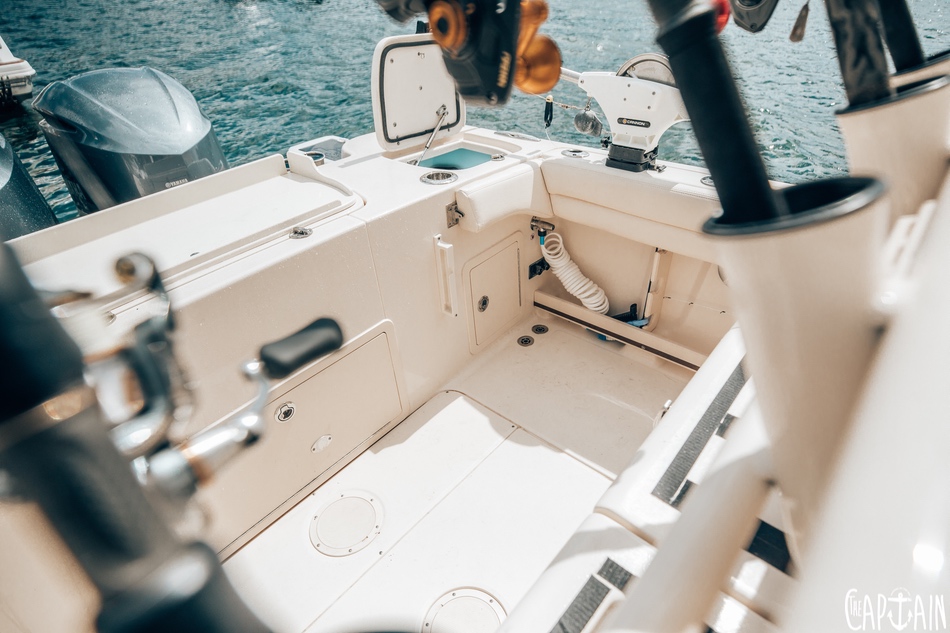



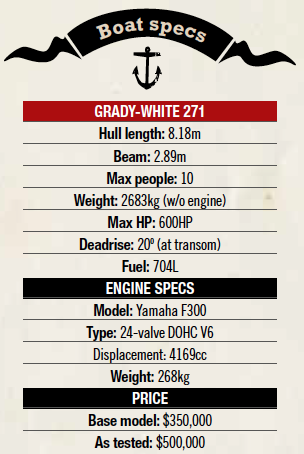


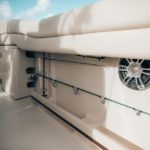

















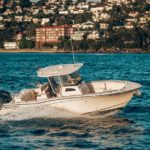





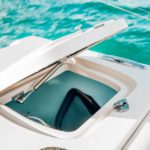










Recent Comments